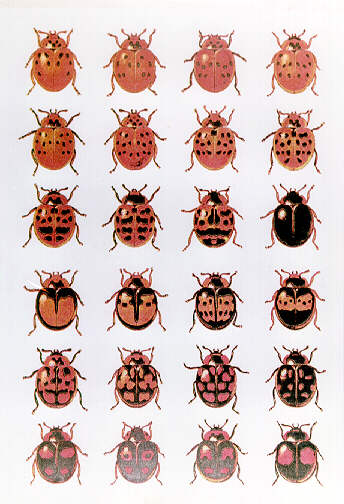
Variability of ladybirds. Theodosius Dobzhansky, one of the founders of the synthetic theory of evolution, began his investigations studying the geographical and intra-population variability of ladybirds. Image copyright Darwin Museum.
| Evolution | ||
| Life | Evolution |
| Life | Life | Evolution – the Modern Synthesis |
|
| Life | (none as yet) | Paleontology |
|
Cosmic Evolution |
Evolution |
 Variability of ladybirds. Theodosius Dobzhansky, one of the founders of the synthetic theory of evolution, began his investigations studying the geographical and intra-population variability of ladybirds. Image copyright Darwin Museum. |
In biology, the process of evolution is the change in a population's genetic structure over successive generations. Specifically, it is the change in allele frequency over time. The many sub-processes of evolution account for the diversity of life, such as genetic inheritance, which accounts for the continuity of traits, mutation, which accounts for novel traits, and natural selection, which accounts for the environmental filtering of traits.
There are four common mechanisms of evolution. The first mechanism is natural selection, a process in which there is differential survival and/or reproduction of organisms that differ in one or more inherited traits. A second mechanism is genetic drift, a process in which there are random changes to the proportions of two or more inherited traits within a population. A third mechanism is mutation, which is a permanent change in a DNA sequence. Finally, the fourth mechanism is gene flow, which is the incorporation of genes from one population into another.
Evolution may in the long term lead to speciation, whereby a single ancestral species splits into two or more different species. Speciation is visible in anatomical, genetic and other similarities between groups of organisms, geographical distribution of related species, the fossil record and the recorded genetic changes in living organisms over many generations. Speciation stretches back over 3.5 billion years during which life has existed on earth. It is thought to occur in multiple ways such as slowly, steadily and gradually over time or rapidly from one long static state to another.
The scientific study of evolution began in the mid-nineteenth century, when research into the fossil record and the diversity of living organisms convinced most scientists that species evolve.] The mechanism driving these changes remained unclear until the theory of natural selection was independently proposed by Charles Darwin and Alfred Wallace in 1858. In the early 20th century, Darwinian theories of evolution were combined with genetics, palaeontology and systematics, which culminated into a union of ideas known as the modern evolutionary synthesis. The synthesis became a major principle of biology as it provided a coherent and unifying explanation for the history and diversity of life on Earth.
Evolution is currently applied and studied in various areas within biology such as conservation biology, developmental biology, ecology, physiology, paleontology and medicine. Moreover, it has also made an impact on traditionally non-biological disciplines such as agriculture, anthropology, philosophy and psychology.
A scientific model, or theory, explaining this process is called a theory of evolution (ToE). The current widely-accepted theory of evolution is the modern evolutionary synthesis, also called the Neo-Darwinian theory. Sometimes, the theory of evolution is simply shortened to "evolution" (as in, "Evolution explains the diversity of life"). (Evolution Wiki, Wikipedia)
As with other truly revolutionary scientific hypotheses such as Aristarchus', Copernicus' and Galileo's heliocentric cosmology, Newton's universal theory of gravitation, Einstein's theory of relativity, Darwin's explanation of the origin and diversity of life on Earth through natural selection totally transformed our understanding of the natural world and our place in the universe. Indeed, the evolution and transformation of life on Earth through geological time simply cannot be understood except through Darwinian evolution, any more than the correct movement of the celestial bodies can be understood without reference to Galileo, Newton, etc. The extraordinary amount of data collected by the life sciences in the one and half centuries since Darwin published origin of the species, have allowed us to develop an integrated understanding of the evolution of life through various physical, chemical, and biological processes over millions of years. MAK110719
| Paleontology | Evolution – the Modern Synthesis |
page last modified MAK111009, edited RFVS111214
Google search box courtesy of Ask Dave Taylor